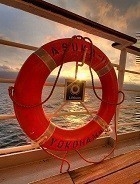Too big to sail? Size of cruise ships stirs safety fears

One of the largest cruise ships in 1985 was the 46,000-ton Carnival Holiday. Ten years ago, the biggest, the Queen Mary 2, was three times as large. Today’s record holders are two 225,000-ton ships whose displacement, a measure of a ship’s weight, is about the same as that of a Nimitz-class aircraft carrier.
Cruise ships keep getting bigger, and more popular. The Cruise Lines International Association said that last year its North American cruise line members carried about 17 million passengers, up from 7 million in 2000. But the expansion in ship size is worrying safety experts, lawmakers, and regulators, who say the supersize craze is fraught with peril.
“Cruise ships operate in a void, from the standpoint of oversight and enforcement,” said James E. Hall, a safety management consultant and chairman of the National Transportation Safety Board between 1994 and 2001. “The industry has been very fortunate until now.”
The perils were visible last year when the Costa Concordia, owned by Carnival Corp., of Miami, capsized off Italy. The accident killed 32 people and revealed fatal lapses in safety and emergency procedures. In February, a fire crippled the Carnival Triumph, stranding thousands without power for four days in the Gulf of Mexico.

Another blaze forced Royal Caribbean’s Grandeur of the Seas to a Bahamas port in May. Pictures showed the stern blackened by fire.
The accidents and fires have heightened concern about the ability of megaships to handle emergencies or large-scale evacuations at sea. Senator John D. Rockefeller IV, Democrat of West Virginia, introduced legislation this summer that would strengthen federal oversight of cruise lines’ safety procedures and consumer protections.
Cruise operators point out that bigger ships have more fire safety equipment, and contend they are safer. After a fire aboard the Carnival Splendor three years ago, Carnival added safety features it says helped with rapid suppression of the fire on the Triumph. After the fire, Carnival said it would spend $700 million to improve its safety operations, including $300 million on its fleet of 24 Carnival Cruise Lines ships. Carnival is the largest cruise operator, owning about half of all cruise ships worldwide.
“We have over time improved the safety of our vessels by better training and better technology and learning from incidents that have happened over the years,” said Mark Jackson, a vice president who joined Carnival after 24 years with the Coast Guard.

Some experts doubt that ships can grow much larger. Today’s biggest ship, Royal Caribbean’s Allure of the Seas, has 2,706 rooms, 16 decks, 22 restaurants, 20 bars, and 10 hot tubs, as well as a shopping mall, a casino, a water park, a half-mile track, a zip line, mini golf, and Broadway-style live shows. It can accommodate nearly 6,300 passengers and 2,394 crew. It’s 1,188 feet long. Its sister ship, Oasis of the Seas, is 2 inches shorter.
Larger ships have fewer options in an emergency, said Michael Bruno, engineering school dean at Stevens Institute of Technology in Hoboken, N.J. “Given the size of today’s ships, any problem immediately becomes a very big problem,” he said.
Rear Admiral Joseph Servidio, a Coast Guard assistant commandant, said in July that the three fires “highlight serious questions about the design, maintenance, and operation of fire safety equipment on board these vessels.”
The head of the International Maritime Organization, the United Nations agency in charge of marine regulations, warned in 2000 of the growing hazards of building larger ships. William O’Neil, the group’s secretary general at the time, said the industry could not “rely on luck holding indefinitely.” One result was new global regulations in 2010 that require new ships to have redundant systems to allow them to return to port even in the worst emergency. About 10 ships built since then comply.
 Bud Darr, senior vice president at the cruise lines association, said ships operate under layers of oversight — from the Coast Guard, auditors hired by cruise operators, and countries like the Bahamas and Panama.
Bud Darr, senior vice president at the cruise lines association, said ships operate under layers of oversight — from the Coast Guard, auditors hired by cruise operators, and countries like the Bahamas and Panama.
“The simple problem is they are building them too big and putting too many people aboard,” said Captain William H. Doherty, a former safety manager for Norwegian Cruise Lines. “The magnitude of the problem is much bigger than the cruise industry wants to acknowledge.”
* Photos sourced from Flickr via Creative Commons and Wikimedia Commons
* Original Story: Google News : Boston Globe (search term: sail)
![]()

Post your comment
You cannot post comments until you have logged in.
Login to post a commentComments
No one has commented on this page yet.
RSS feed for comments on this page | RSS feed for all comments